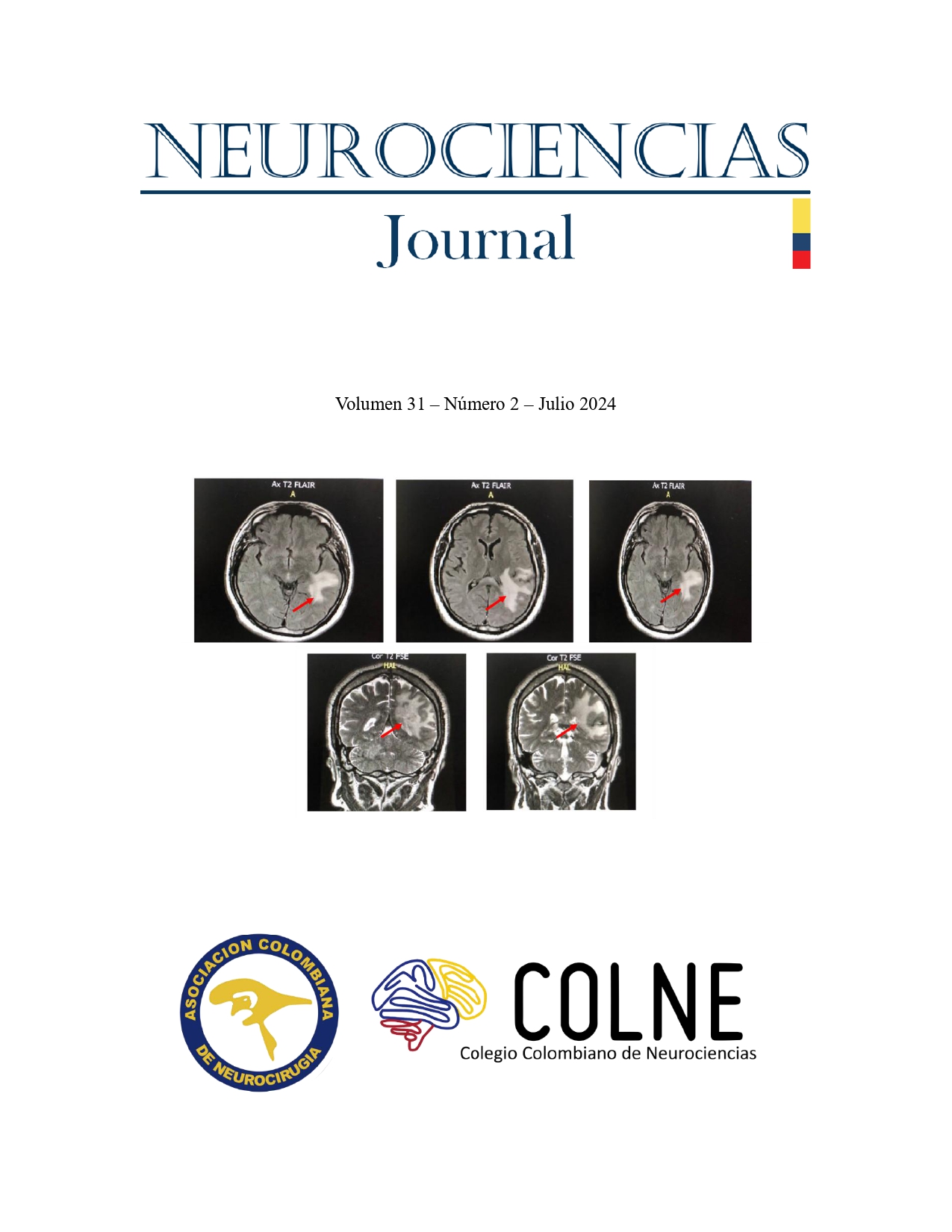Congenital kyphoscoliosis with hemivertebra: a 14-case series and literature review
DOI:
https://doi.org/10.51437/nj.v31i2.419Palabras clave:
spine, congenital scoliosis, diagnosis, treatmentResumen
Background: Hemivertebra results from an anomaly in the development of the vertebral body and is a cause of congenital scoliosis. Objective: To describe our experience with the surgical correction of congenital kyphoscoliosis with hemivertebra and review the literature to guide its diagnosis and timely management. Material and methods: A retrospective case series study, from January 2006 to July 2017, was conducted by reviewing the medical records of patients under 14 years of age included. Results: The study included 14 patients aged 3 months to 13 years, with a mean age of 6.9 years, 78.6% were male. Follow-up ranged from 18 to 144 months. Two patients were lost to follow-up. Twenty-two hemivertebrae were documented, 10 in the thoracic spine (45.4%), six in the cervical spine (27.3%), and six in the lumbar spine (27.3%). The most common surgical procedure was hemivertebra resection along with instrumented fusion, the osteosynthesis material being removed from four patients at ≥2 years of follow-up. Three patients had none-neurological complications. Conclusion: Hemivertebra resection along with instrumented fusion is a safe and effective surgical procedure to prevent and correct spinal deformity. In addition to early diagnosis and treatment, adequate follow-up by a multidisciplinary team is needed for better results.
Citas
Tanaka T, Uhthoff H. The pathogenesis of congenital vertebral malformations. Acta Orthop Scan. 1981;52:413-25.
Johal J, Loukas M, Fisahn C, Chapman J, Oskouian R, Tubbs R. Hemivertebrae: a comprehensive review of embryology, imaging, classification and management. Childs Nerv Sist. 2016;32(11):2105-9.
Nasca RJ, Stilling FH III, Stell HH. Progression of congenital scoliosis due to hemivertebrae and hemivertebrae with bars. J BoneJoint Surg Am. 1975;57:456– 66.
Storm, PB and Samdani, AF. Other causes of pediatric deformity. Neurosurg Clin N Am. 2007;18:317-23.
Lin M, Zhao S, Liu G, Huang Y, Yu C, Zhao Y, et al. Identification of novel FBN1 variations implicated in congenital scoliosis. J Hum Genet. 2020;65:221–30.
Giampietro PF, Blank RD, Raggio CL. Congenital and idiopathic scoliosis: clinical and genetic aspects. Clin Med Res. 2003;1:125-36.
Farley FA, Hall J, Goldstein SA. Characteristics of congenital scoliosis in a mouse model. J Pediatr Orthop. 2006;26:314-46.
Aberg A, Westbom L, Kallen B. Congenital malformations among infants whose mothers had gestational diabetes or preexisting diabetes. Early Hum Dev. 2001;61:85-91.
Conion RA, Reaume AG, Rossant J. Notch 1 is required for the coordinate. Development. 1995;121:1533-45
Bessho Y, Miyoshi G, Sakata R. Hes7: a bHLH-type repressor gene regulated by Notch and expressed in the presomitic mesoderm. Genes Cells. 2001;6:175-85.
Bulman MP, Kusumi K, Frayling TM. Mutations in the human delta homologue, DLL3, cause axial skeletal defects in spondylocostal dysostosis. Nat Genet. 2000;24:438-41.
Erol BK, Lou J, Dormans JP. Etiology of congenital scoliosis. UPOJ. 2002;15:37-42
Guevara Villazón F, de la Cruz Álvarez S, Muñiz Luna L. Proximal junctional kyphosis in patients with scoliosis due to hemivertebra operated on with posterior fusion [Cifosis de unión proximal en paciente con escoliosis por hemivértebra operados con artrodesis posterior]. Ortho-tips. 2017;13(1):23-9.
Winter RB, Lonstein JE, Boachie-Adjei O. Congenital spinal deformity. Instr Course Lect. 1996;45:117–27.
McMaster MJ, Ohtsuka K. The natural history of congenital scoliosis: a study of 251 patients. J Bone Joint Surg. 1982;64A:1128.
McMaster MJ, Singh H. The surgical management of congenital kyphosis and kyphoscoliosis. Spine. 2001;26(19):2146–54.
McMaster MJ, Singh H. Natural history of congenital kyphosis and kyphoscoliosis of one hundred and twelve patients. J Bone Joint Surg Am. 1999;81;1367-83.
Hedequist D, Emans J. Congenital scoliosis. J Am Acad Orthop Surg. 2004;12(4):266–75.
Basu PS, Elsebaie H, Noordeen MH. Congenital spinal deformity: a comprehensive assessment at presentation. Spine. 2002;27(20):2255–9.
Campos MA, Weinstein SL. Pediatric Scoliosis and Kyphosis. Neurosurgery Clinics. 2007;18(3):515–29.
Fardon DF. North American spine society. Orthopaedic knowledge update. Spine 2. 2nd ed. Rosemont (IL): American; 2002.
Rommelspacher Y, Bode H, Ziob J, Struwe C, Kasapovic A, Walter SG, et al. Treatment with and Without Stabilizing Lumbar Spinal Orthosis after One- or Two-level Spondylodesis: A Randomized Controlled Trial. Technol Health Care. 2020;28(5):541-9.
Mackel CE, Jada A, Samdani AF, Stephen JH, Bennett JT, Baaj AA, et al. A comprehensive review of the diagnosis and management of congenital scoliosis. Childs Nerv Syst. 2018;34(11):2155-71.
Campbell RM Jr, Smith MD, Mayes TC, Mangos JA, Willey-Courand DB, Kose N, et al. The effect of opening wedge thoracostomy on thoracic insufficiency syndrome associated with fused ribs and congenital scoliosis. J Bone Joint Surg Am. 2004;86(8):1659-74.
Brustowicz RM and Hall JE. In defense of the wake-up test. Anesth Analg. 1988;67:1019.
Mooney JF, Bernstein R, Hennrihus Wl. Neurologic risk management in scoliosis surgery. J Pediatr Orthop. 2002;22:683-9
Polly DW, Klemme WR, Fontana JL. A modified wake-up test for use in very young children undergoing spinal surgery. J Pediatr Orthop. 2002;20:64-5
Hedequist DJ. Surgical Treatment of Congenital Scoliosis. Orthop Clin North Am. 2007;38(4):497–509.
Suk SI, Chung ER, Kim JH, Kim SS, Lee JS, Choi WK. Posterior vertebral column resection for severe rigid scoliosis. Spine. 2005;30(14):1682–7.
Zhu X, Wei X, Chen J, Li C, Li M, Qiao Y, et al. Posterior hemivertebra resection and monosegmental fusion in the treatment of congenital scoliosis. Ann R Coll Surg Engl. 2014;96(1):41-4.
Hedequist DJ, Hall JE, Emans JB. Hemivertebra excision in children via simultaneous anterior and posterior exposures. J Pediatr Orthop. 2005;25:60–3.
Huang Y, Feng G, Liu L, Yang X, Song Y, Zhou C, et al. Posterior hemivertebra resection for upper thoracic congenital scoliosis: be aware of high risk of complications. J Pediatr Orthop B. 2019;28(1):1-9.
Holte DC, Winter RB, Lonstein JE, Denis F. Excision of hemivertebra and wedge resection in the treatment of congenital scoliosis. J Bone Joint Surg. 1995;77:159–71.
Klemme W, Polly D, Orhowski J. Hemivertebra excision for congenital scoliosis in very young children. J Pediatr Orthop. 2001;21:761–4
Lazar R, Hall J. Simultaneous anterior and posterior hemivertebra excision. Clin Orthop. 1999;363:76–84.


